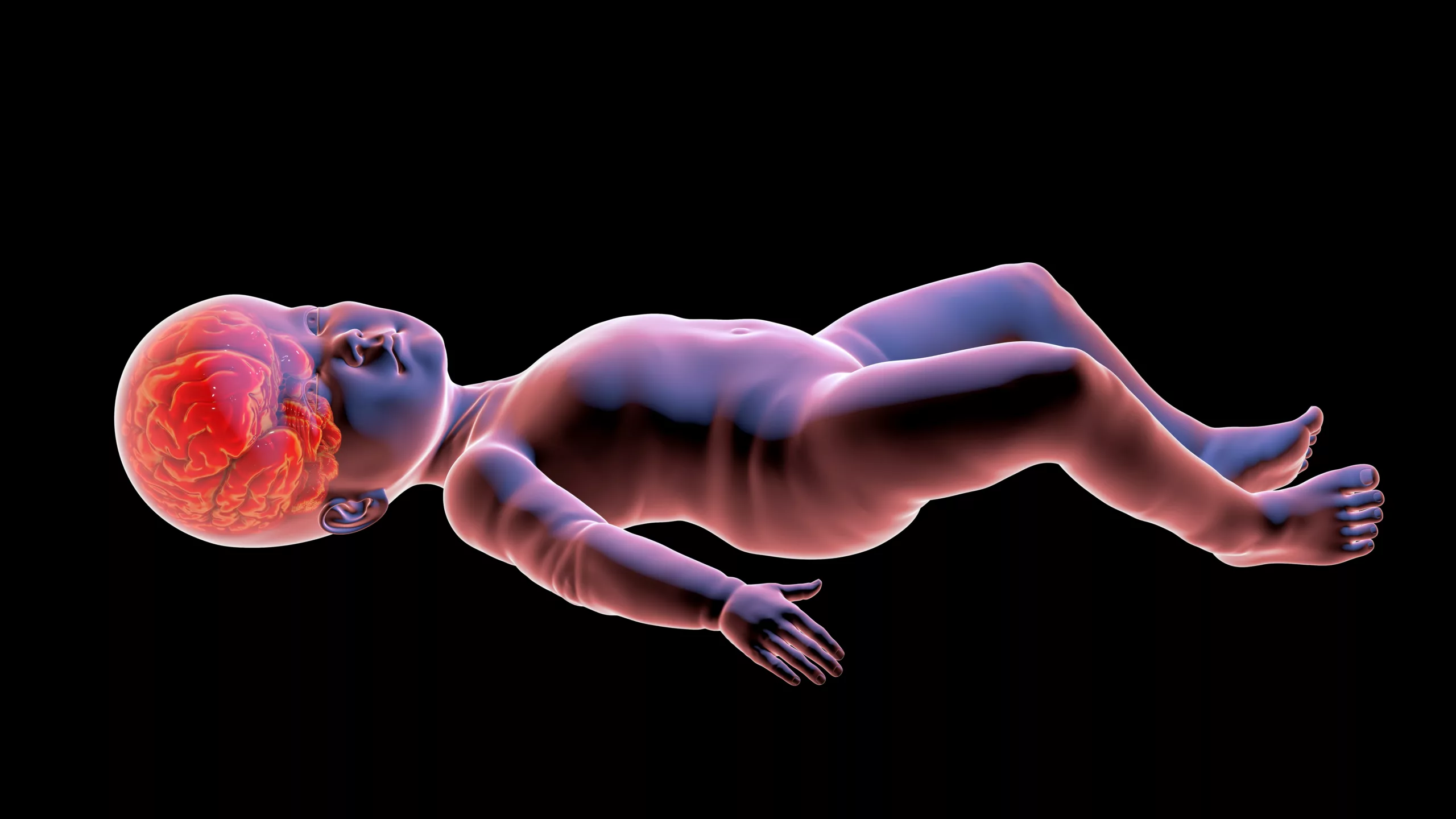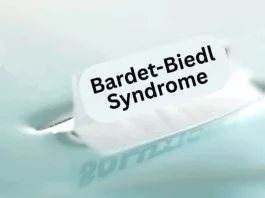
What is Zellweger Syndrome?
Zellweger syndrome is a rare genetic disorder that disrupts cellular function and usually appears soon after birth. Named after Dr. Hans Zellweger in 1964, it is a part of peroxisome biogenesis disorders (PBDs)1 Bose, M. (2023) Zellweger spectrum disorders – symptoms, causes, treatment: Nord, National Organization for Rare Disorders. Retrieved 12 August 2023 https://rarediseases.org/rare-diseases/zellweger-spectrum-disorders/ that occur due to mutations in pexin (PEX) genes. It is characterized by the reduction or absence of functional peroxisomes, which are cellular structures responsible for various metabolic processes, including the breakdown of very long-chain fatty acids (VLCFAs) and the synthesis of plasmalogens, essential components of cell membranes. Babies born with Zellweger syndrome have problems with cognitive functions and metabolism. It leads to defects in the kidney, brain, liver, and other body functions.
Craniofacial abnormalities, neurological defects, liver dysfunction, and developmental delay are common manifestations of this disease. It is the forerunner of the group of diseases known as peroxisome disorders that share a common biochemical basis. The disorders in the class of peroxisome disorders are also called the Zellweger spectrum.
Causes
Mutations among 13 PEX genes lead to Zellweger syndrome. 61% of people with Zellweger syndrome have a mutation in the PEX1 gene.2Steinberg, S.; Dodt, G.; Raymond, G.; Braverman, N.; Moser, A.; Moser, H. (2006). “Peroxisome biogenesis disorders”. Biochimica et Biophysica Acta (BBA) – Molecular Cell Research. 1763 (12): 1733–48. doi:10.1016/j.bbamcr.2006.09.010. PMID 17055079. These genes regulate the function of peroxisomes. Peroxisomes are cell organelles that control various cell functions, including the breakdown of lipids and toxins. Improper peroxisomal function leads to improper development of body systems, including the liver, kidney, brain, bones, eyes, etc.
Symptoms
The symptoms show up shortly after birth and aggravate with time.3Steinberg, S.; Dodt, G.; Raymond, G.; Braverman, N.; Moser, A.; Moser, H. (2006). “Peroxisome biogenesis disorders”. Biochimica et Biophysica Acta (BBA) – Molecular Cell Research. 1763 (12): 1733–48. doi:10.1016/j.bbamcr.2006.09.010. PMID 17055079. Babies born with this syndrome have distinct facial features like:
- Flattened face
- Prominent forehead
- Epicanthal folds
- Widely-set eyes
- Wide nose bridge
- Poorly developed eyebrow ridges
- Hypotonia
Other common symptoms are:
- Problems with feeding
- Impaired hearing and vision
- Jaundice
- Gastrointestinal bleeding
- Seizures
- Enlarged liver
- Weak muscle tone
- Cognitive impairment
Clinical Manifestation of Zellweger Syndrome
Individuals affected with Zellweger syndrome show different clinical features at different ages according to the severity of the disease. Since it is a spectrum disorder, it has a continuous phenotype instead of discrete characteristics.
Patients with this syndrome are divided into three groups according to the age at which the symptoms appear. This classification helps decide appropriate diagnostic techniques, treatment protocols, and patient counseling.

Neonatal Infantile Presentation
Patients in this group show characteristic facial dysmorphism in the neonatal period. Additionally, hepatic dysfunction, epileptic seizures, and intense hypotonia are common. Hearing loss and vision defects like glaucoma, cataracts, and retinopathy are present but not recognized at early stages. The symptoms resemble classic Zellweger syndrome with a poor prognosis and life expectancy of not more than one year.4 Klouwer, F.C.C. et al. (2015a) Zellweger Spectrum Disorders: Clinical overview and management approach – Orphanet Journal of rare diseases, BioMed Central. Retrieved 12 August 2023https://ojrd.biomedcentral.com/articles/10.1186/s13023-015-0368-9
Childhood Presentation
Patients with a childhood presentation have variable symptoms. The most common features are delayed development, ocular abnormalities, and sensorineural defects. Moreover, a patient may present with hepatic dysfunction, leukodystrophy, adrenal insufficiency, and epileptic seizures. The prognosis depends on the body systems affected by the disease. Still, most patients do not reach adolescence and die earlier.
Adolescent-Adult Presentation
The disease manifests in adolescence or adulthood with mild symptoms. The most conforming features are sensorineural hearing abnormalities and ocular defects. Other symptoms, like craniofacial dysmorphism, are variably present in some individuals or completely absent in others. Furthermore, adrenal insufficiency may be common with some degree of neurological defects and delayed development.
Diagnosis
Physicians can diagnose Zellweger syndrome from characteristic clinical features that appear soon after birth. However, further diagnosis is made on a biochemical basis using the following tests:
- Imaging tests: The doctor may perform an ultrasound to examine the size and functioning of vital organs like the liver and kidney. Brain MRI is performed to assess brain functioning.
- Genetic tests: The presence of a mutated PEX gene in the blood indicates ZS syndrome.
- Blood and urine test: Patients with Zellweger syndrome have problems with metabolism. Abnormal metabolism leads to the accumulation of certain substances in the body. High levels of certain substances, such as long-chain fatty acids, in blood and urine are evidence.
- Gene testing: It is a more specific test for diagnosis. It involves Gene-target testing and Comprehensive genomic testing.5 Steinberg, S.J. (2020) Zellweger Spectrum Disorder – GeneReviews® – NCBI Bookshelf, National Library of Medicine (Gene reviews [Internet]). Retrieved 10 August 2023 from https://www.ncbi.nlm.nih.gov/books/NBK1448/
Zellweger Syndrome Treatment
Zellweger syndrome is a rapidly advancing disease with a high death rate. No standard treatment protocol is available to cure Zellweger syndrome, so treatment is mainly symptomatic and palliative. The US FDA has approved the use of cholic acid in Zellweger syndrome. Cholic acid helps improve the absorption of fat-soluble vitamins, which is impaired in Zellweger syndrome.
Some other supportive measures that can improve symptoms are:
- Hearing aids: Various hearing aids, such as cochlear implants, can help patients with hearing loss.
- Cataract removal: Removing cataracts, using glasses, or referring patients to an ophthalmologist for better advice can assist patients with visual impairment.
- Antiepileptic drugs: These drugs reduce the risk of seizures in a patient with neurologic abnormalities.
- Vitamin K supplements: Vitamin K deficiency can lead to bleeding disorders in a Zellweger syndrome patient. Vitamin K supplements reduce the chance of coagulopathy, a Zellweger syndrome complication.
- Gastrostomy: Gastrostomy, also known as ‘tube feeding’, involves surgically inserting a tube across the abdomen into the stomach. It is an alternative feeding option to satisfy the nutritional requirements of patients who have problems with feeding.
- Other vitamin supplements to counter the deficiency of fat-soluble vitamins.
Zellweger Spectrum Disorders
Zellweger spectrum disorders is a subclass of Peroxisome Biogenesis Disorders caused by defective peroxisome formation and function. Mutations in the genes that regulate the development and function of peroxisomes lead to these disorders.
The Zellweger spectrum consists of four disorders with overlapping features, one of which is the Zellweger syndrome. Other disorders in the Zellweger spectrum are:
- Heimler Syndrome: This is characterized by tooth problems and hearing loss that occurs during early childhood.
- Neonatal Adrenoleukodystrophy: It causes hearing and vision loss and adversely affects the baby’s brain, muscles, and spine.
- Infantile Refsum Syndrome: It is the least severe disorder that causes poor development and impaired muscle movement in infants.6 Klouwer, F.C.C., et al. (2015) Zellweger Spectrum Disorders: Clinical overview and management approach – orphanet journal of rare diseases, BioMed Central. Retrieved 10 August 2023 from https://ojrd.biomedcentral.com/articles/10.1186/s13023-015-0368-9
These disorders have some common symptoms, such as cognitive impairment, liver enlargement, and facial features characteristic of Zellweger syndrome. Zellweger syndrome is the most severe among other disorders from the same spectrum. It is also known as cerebrohepatorenal syndrome, which is a fatal condition.
Zellweger Syndrome Inheritance
Zellweger syndrome is passed on as an autosomal recessive trait. It occurs due to mutations in one of the PEX genes.7 Distel, B. et al. (2015) A unified nomenclature for Peroxisome Biogenesis Factors, University of Texas Southwestern Medical Center. Retrieved 12 August 2023 https://utsouthwestern.pure.elsevier.com/en/publications/a-unified-nomenclature-for-peroxisome-biogenesis-factors These genes contain information on the normal functioning of proteins known as peroxins. Peroxisomes are single membrane-bound organelles that regulate various important cell functions. These organelles contain nearly 50 enzymes for lipid breakdown.
Zellweger Syndrome Prognosis
Neonates with Zellweger syndrome usually survive less than a year and have poor prognoses. Less severe forms of the disease develop during childhood, and patients can have a slightly longer lifespan with timely diagnosis. However, these children develop advanced liver disease and die due to complications.
Adolescents who show up with Zellweger syndrome live a little longer.8 Elumalai, V. (2023) Zellweger syndrome – StatPearls – NCBI Bookshelf, National Library of Medicine. Retrieved 12 August 2023 https://www.ncbi.nlm.nih.gov/books/NBK560676/ Nevertheless, these patients develop neurological complications at a later age. Other diseases in the Zellweger spectrum have a better prognosis, and patients live to adulthood.
Final Words
Zellweger syndrome is a rare congenital disorder that affects vital functions and development of the body. It shows up shortly after birth, and patients develop serious metabolic and neurologic complications later in life. Nevertheless, well-timed diagnosis and appropriate supportive measures can improve a patient’s quality of life. Zellweger syndrome impacts multiple body systems, so there should be teamwork among professional staff for appropriate patient care.
Refrences
- 1Bose, M. (2023) Zellweger spectrum disorders – symptoms, causes, treatment: Nord, National Organization for Rare Disorders. Retrieved 12 August 2023 https://rarediseases.org/rare-diseases/zellweger-spectrum-disorders/
- 2Steinberg, S.; Dodt, G.; Raymond, G.; Braverman, N.; Moser, A.; Moser, H. (2006). “Peroxisome biogenesis disorders”. Biochimica et Biophysica Acta (BBA) – Molecular Cell Research. 1763 (12): 1733–48. doi:10.1016/j.bbamcr.2006.09.010. PMID 17055079.
- 3Steinberg, S.; Dodt, G.; Raymond, G.; Braverman, N.; Moser, A.; Moser, H. (2006). “Peroxisome biogenesis disorders”. Biochimica et Biophysica Acta (BBA) – Molecular Cell Research. 1763 (12): 1733–48. doi:10.1016/j.bbamcr.2006.09.010. PMID 17055079.
- 4Klouwer, F.C.C. et al. (2015a) Zellweger Spectrum Disorders: Clinical overview and management approach – Orphanet Journal of rare diseases, BioMed Central. Retrieved 12 August 2023https://ojrd.biomedcentral.com/articles/10.1186/s13023-015-0368-9
- 5Steinberg, S.J. (2020) Zellweger Spectrum Disorder – GeneReviews® – NCBI Bookshelf, National Library of Medicine (Gene reviews [Internet]). Retrieved 10 August 2023 from https://www.ncbi.nlm.nih.gov/books/NBK1448/
- 6Klouwer, F.C.C., et al. (2015) Zellweger Spectrum Disorders: Clinical overview and management approach – orphanet journal of rare diseases, BioMed Central. Retrieved 10 August 2023 from https://ojrd.biomedcentral.com/articles/10.1186/s13023-015-0368-9
- 7Distel, B. et al. (2015) A unified nomenclature for Peroxisome Biogenesis Factors, University of Texas Southwestern Medical Center. Retrieved 12 August 2023 https://utsouthwestern.pure.elsevier.com/en/publications/a-unified-nomenclature-for-peroxisome-biogenesis-factors
- 8Elumalai, V. (2023) Zellweger syndrome – StatPearls – NCBI Bookshelf, National Library of Medicine. Retrieved 12 August 2023 https://www.ncbi.nlm.nih.gov/books/NBK560676/




